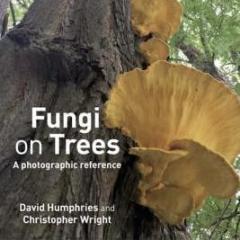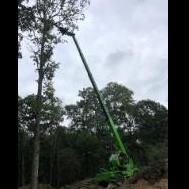-
Posts
23,485 -
Joined
-
Last visited
-
Days Won
3
Content Type
Profiles
Forums
Classifieds
Tip Site Directory
Blogs
Articles
News
Arborist Reviews
Arbtalk Knot Guide
Gallery
Store
Freelancers directory
Everything posted by David Humphries
-

Tis the season to see Fungi, fa la la la la....
David Humphries replied to David Humphries's topic in Fungi Pictures
No idea -
-
Thanks for the follow up
-
Birch with Fomes fomenatrius and Piptoporus betulinus on the same branch. A more common occurrence in the north of the UK but less common to see both species on the same tree host here in the south east. The Fomes decay is a simultaneous white rot and the Piptoporus decay is a brown rot, both are clearly evident here in seperate branch sections found on the floor. The tip of the branch is where the majority of the Piptoporus colonisation and fruiting is located and the base of the branch is mostly colonised by the Fomes. Sliced and diced to have a closer look at the over lapping decay colonisations along the branch. Francis Schwarze (Fungal strategies of Wood Decay in Trees) mentions that a common occurance in advanced colonisation of Fomes decay are cracks filled with white/yellow mycelial skins, which can be clearly seen in these last cross sections taken close to the branch union just below the fruiting body.
-

Managing Trees with Decay & Dysfunction
David Humphries replied to David Humphries's topic in Tree health care
No, as I mentioned above, Laetiporus decay was the only 'known' associate before that tree failed. That tree never had resinaceum fruiting on it before. -

Managing Trees with Decay & Dysfunction
David Humphries replied to David Humphries's topic in Tree health care
Red oak with long time colonisation of the white rot dysfunction and decay of Ganoderma resinaceum. Over the last 12 years we've been mapping the decay in the trunk via watching the annual fruit body locations, the ongoing buttress development, accustic signature (nylon hammer) and utilising both the earlier Dmp decay microdrill and then the more advanced IML Resi Pd400 to determine the ongoing residual wall strength and proportion. A neighbouring red oak failed at the base (Laetiporus) in the St Judes storm of a few years back. The exposure to further wind load from the loss of its neighbour has led us to eventually start on a phased reduction by removing 2m of the canopy. (Rob and Jack climbing) Depending on development of epicormic buds (red oak are known for strong epi growth), we intend to continue the reductions to bring the canopy down further in height and volume. -
Hi Nick, thanks for sharing. Any shots of the base of the trunk before you felled it. Would be interested in seeing if there were any buttress fluting?
-

Chalara fraxinea - Generic thread
David Humphries replied to David Humphries's topic in Tree health care
As a reflection of the distribution, I witnessed chalara on my travels last week at 3 seperate sites across the south and east of the U.K. Where I work at an open space in north London, At the 800 year old continuous coppice of Bradfield woods near Bury St Edmunds, Suffolk and on the chalk down lands of Lyscombe and Highdon in Dorset whilst on an ATF field trip. .........depressing -
Tidy
-
Californian bay laurel/headache tree (Umbellularia californica) is one to consider have a look at this old thread on toxic trees.........
-
Good thread Andy, will be interesting to hear others memories. Anniversaries are weird things aren't they, certainly make you ponder on your own involvement but equally will mean jack to a large number of those in the industry who might not have even been born by then. There hasn't really been any weather events in the UK since (accept perhaps the one at the begging on the nineties) that have been anywhere near as devastating as the 'great storm' On reflection, (I was at the end of a Hort apprentice at the time) that storm was the single thing that led to my career in Arboriculture. Joining up the tree team and helping to clear up the devastation for months afterwards. We had huge fires going in our car parks for weeks (wonder what Sadiq Khan would have said about that) that ourselves and our neighbouring local authorities used to get shot of the timber. Such a waste. I was talking to a well known consultant in the south recently who was retelling how he went from a three man outfit pre-storm, to 15 guys over the storm clear up and the next couple of years, then business just dried up as home/land owners just didn't have the money to spend on trees, so he wound down the gangs and went in to consultancy. This particular anniversary led me to think about and write an article recently on the effect of the storm on Ancient and veteran trees, I probably wouldn't have thought about it had the anniversary not been coming up.
-

Tis the season to see Fungi, fa la la la la....
David Humphries replied to David Humphries's topic in Fungi Pictures
-

My Last Climbing Hurrah !
David Humphries commented on David Humphries's blog entry in David Humphries
Cheers Sean, appreciated. Would be good to see you put a blog together to update on your recovery and how you adapted to it and all the other stuff you've been up to. -

Tis the season to see Fungi, fa la la la la....
David Humphries replied to David Humphries's topic in Fungi Pictures
Done bits and pieces, but not considered a whole book on me tod, that's a fairly big undertaking. I did contribute most of the in situe fruit body images to the Arb Associations Fungi on Trees - An Arborists field guide, helped Steve put together the Arbtalk Fungi App and have written a few articles on fungi and decay. Oddly enough I was just literally asked today to help put together a new field guide, but imagine that will be a while till it becomes available. I sometimes even inspire myself -

Tis the season to see Fungi, fa la la la la....
David Humphries replied to David Humphries's topic in Fungi Pictures
-

Tis the season to see Fungi, fa la la la la....
David Humphries replied to David Humphries's topic in Fungi Pictures
That is a sizeable puffball mate, did it make it home to be gourmetfied, or was it riddle with slugs and maggots? -
-
Mycorrhizal ring of Milk caps (Lactarius) amongst the ancient coppice hazel, oak and birch woodland of Bradfield Woods in Suffolk .
-

Tis the season to see Fungi, fa la la la la....
David Humphries replied to David Humphries's topic in Fungi Pictures
I was in an 800 year old continuous coppice hazel/ash, birch & oak standard woodland in Suffolk today. Plenty of fly agarics and other stuff. -

Tis the season to see Fungi, fa la la la la....
David Humphries replied to David Humphries's topic in Fungi Pictures
Nice to have the fly on your tree-step Mick. may have just colonised via spore Any birch/oak woodlands near by? . -
Marula's on the money. What's the host for the second one?
-
The other seedlings are still going strong but not sure I can take the chance to replace the taken one in the same spot. It may have been a random thoughtless moment but it may also have been an act of a disgruntled local objecting to management of any form. There's been a number of acts vandalism (arson, trunk snapping, uprooting) over the years. Sorry to hear of the loss of your little piece of urban Caledonian forest Julian, that must of been depressing. I kinda hope that our little pine is still thriving in a new location.
-
Excellent Entism
-
the Human disorder, a strange affliction that makes individuals do pointless things at the expense of others good intentions.........hmmmmmm. So after 7 years of nurturing and planned succession, someone decides to destroy those best layed plans on a whim. Frustration is one word that begins with an F that comes to mind, there are others........
-
heavy lean or exposed to prevailing wind load?



































































